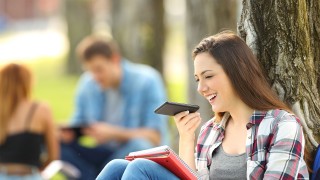How chatbots benefit higher ed

Key takeaways
- Chatbots perform two important tasks: analyze a question and frame an answer
- To be effective, chatbots should provide a consistent and user-friendly customer experience
- Chatbots benefit higher ed by providing information quickly and engaging users through personalized responses
The way people are interacting with their devices is changing as they seek to access information quickly. They want instant answers to their questions, and students are no exception. They want—and expect— instant communication.
In order to meet those expectations, applications are integrating conversational interfaces, otherwise known as chatbots. As the name indicates, chatbots are chat applications with a robot on one side of the conversation that can respond to either voice or text. Chatbots are everywhere—from voice-based assistants like Amazon Alexa and Google Home to text-based assistants like messenger apps and SMS services.
With chatbot technology, institutions can meet the needs and expectations of today’s students. Chatbots are available 24/7/365 and can provide information quickly and in many languages, making them useful at institutions across the globe. And advances in natural language processing (NLP) have enabled computer-based applications to better interpret languages. Now, the NLP engine can understand that "How much is due?" is the same question as "How much do I owe?" These advances are opening the door to more chatbot applications.
How do chatbots work?
There are two types of chatbots: simple and intelligent.
Simple chatbots work with predefined rules or keywords. Each rule or keyword needs to be defined by the developer separately to deal with different possible scenarios so that the chatbot understands the questions asked. For example, a student might ask, “What’s the registration process for classes?” or more specifically, “How do I register for English 101?” If the chatbot does not understand, the developer must make updates to clarify the response. Simple chatbots are easy for developers to implement but every possible query needs to be hard coded, which can be time consuming.
Intelligent chatbots are trained to do different tasks. These chatbots are built using artificial intelligence (AI) and NLP technologies to answer and understand user queries. They don’t rely on predefined rules to understand; instead, they rely on pretrained models. All questions and answers are recorded and are logged in the algorithm to use for future training. The initial implementation of an intelligent chatbot is difficult because it requires a bigger set of questions but these chatbots are trained to identify and understand when questions are similar, making future updates easier.
For both types, there are two important tasks that the chatbot performs on the backend. First, it analyzes the request or question asked. Then, it frames an answer to the query. This process seems simple but in practice is complex and works the same whether the chatbot is voice- or text-based.

The ability to identify context (i.e. the setting in which the question or query is asked) and to extract information from the request is the most important part of any chatbot algorithm. If the algorithm fails to understand this, then the chatbot won’t be able to respond correctly.

In the example pictured, a student asks, “How much do I owe?” The chatbot algorithm processes this request as a question about fees and takes into consideration where the student asked the question. The context helps determine the response.
Once the chatbot interprets the user’s request correctly, it will provide the most appropriate answer for that request. This answer may come from multiple sources:
- A predefined text
- A text retrieved from a data center that contains different responses
- A response from an enterprise system
- A follow-up question if more information is required
- A response with a similar question if the request is ambiguous
To be effective, chatbots should provide a consistent and user-friendly customer experience. Both simple and intelligent chatbots should have easy access to data and be able to update that data based on the conversational exchange between the chatbot and the user. It should also understand the context of the screen(s) it’s linked to and stay current in terms of content. This ensures that the chatbot is providing the user with the most relevant and up-to-date information.
If the chatbot cannot answer the user’s query, it should provide continuous feedback until the question is answered or connect the user to a human who can answer the question via a live chat function.
How do chatbots benefit higher education institutions?
When new students arrive on campus, many ask the same questions. “Which courses are available this semester?” “How do I register?” “Who is my advisor?” These questions extend to financial aid as well. “Am I eligible?” “How do I apply?” “Why haven’t I received my financial aid?”
Chatbots can help students get answers to their questions quickly and efficiently. They don’t have to read through a lengthy FAQ document or wait to receive an email response from an administrator. They can get an instant response, thus reducing wait times and improving the student experience.
Chatbots can also connect students with their advisors or provide information when they don’t want to speak to their advisor in person. They can ask questions about their major, find out what would happen if they changed majors, how that would impact their course load, and get course recommendations. A chatbot can talk with other AI applications to make it easier for users to get relevant results.
For staff, chatbots reduce the manual effort of answering the same questions repeatedly, freeing time and resources to focus on other tasks. Staff can also benefit from chatbots when there are changes in procedures or processes. Chatbots can deploy updates immediately to ensure the new information is available everywhere and all at once. This improves communication and increases the speed at which staff can be provided with new information.
Not only do chatbots provide information quickly but they engage users through personalized experiences. This ultimately helps institutions improve their customer service and meet the needs of their students and staff.




